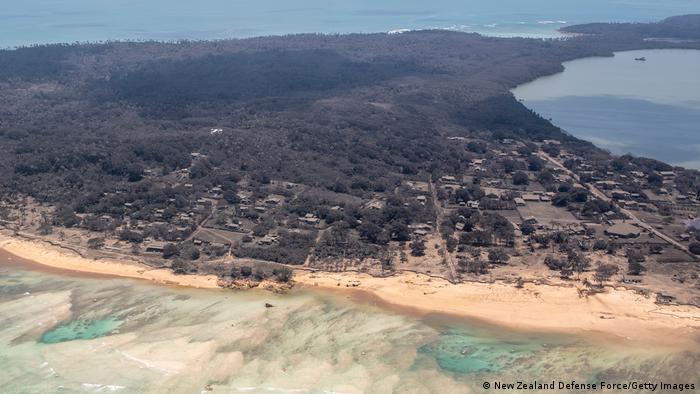
Officials in Tonga confirmed that at least three people have died following Saturday's massive volcanic eruption and tsunami in the government's first statement since the catastrophe.
A closed airport and lack of communication have continued to hinder international relief measures on the Pacific island nation, even as significant damage was reported along the western coast of the country’s main island on Tuesday.
What is the extent of the damage?
Tonga officials said three deaths were confirmed so far.
In the first known death from the catastrophe, British national Angela Glover, 50, was killed in the tsunami as she attempted to save dogs at a rescue shelter she had set up with her husband in Tonga, her brother said.
The Tonga government confirmed her death, adding that at least two other people have also died. Officials did not immediately provide figures on the number of injuries.
"Water supplies have been seriously affected by the volcanic ash," the government said in a statement. "Challenges to the sea and air transportation remain due to damage sustained by the wharves and the ash that is covering the runways. Domestic and international flights have been deferred until further notice as the airports undergo clean-up."
The New Zealand High Commission reported damage on the island of Tongatapu, which is home to many holiday resorts, and the waterfront of capital Nuku'alofa.
The United Nations also said that satellite visuals showed extensive damage on the western coast of Tongatapu, with several resorts and houses destroyed or severely damaged.
Extent of injuries unclear
High waves from the eruption have also affected faraway Peru, where two women drowned. The country also reported an oil spill after a ship was jolted while transferring oil at a refinery.
The official toll of injuries and damage from the disaster on Tonga is still unclear, as the South Pacific archipelago has remained severed from the rest of the world after its main undersea communications cable was cut during the eruption on the uninhabited volcanic island of Hunga-Tonga-Hunga-Ha'apai. Repairing the cable is likely to take weeks.
"We don't have any further information that would suggest... significant casualties, although, as you would appreciate, information is still relatively patchy," Australia's Minister for the Pacific Zed Seselja said on Nine's Today show on Tuesday.
He said the airport could likely open by Wednesday, with volcanic ash currently preventing planes from landing safely.
"The priority now will be to get supplies to Tonga, and the biggest constraint on that at the moment ... is the airport. There is still a significant amount of ash," Seselja said.
Virus concerns, international aid on standby
Australia and New Zealand had sent surveillance planes on Monday to assess the damage.
Seselja said Australian police had reported significant damage along beaches with "houses thrown around."
Australian navy ship HMAS Adelaide was on standby for humanitarian assistance and disaster relief support if requested by the Tonga government.
New Zealand said a Hercules C-130 aircraft was on standby to deliver aid supplies as soon as it was safe to land on Tongatapu.
But Tonga's deputy head of mission in Australia, Curtis Tu'ihalangingie, said Tonga was concerned that aid deliveries could spread coronavirus in the COVID-free nation.
"We don't want to bring in another wave — a tsunami of COVID-19," Tu'ihalangingie told news agency Reuters. He urged the public to wait for a disaster relief fund to donate, adding that any aid sent to Tonga would need to be quarantined, and it was possible that no foreign personnel would be allowed to leave the aircraft.
Distress signal detected
The UN said on Tuesday that it had detected a distress beacon from Tonga.
The UN Office for the Coordination of Humanitarian Affairs (OCHA) expressed concern about the small low-lying islands of Mango and Fonoi. An active distress signal was detected from Mango.
"Communication is still the most challenging single issue as internet and international phone lines are still out of order," the OCHA said. "Satellite phones are the only reliable instrument for communication with the outside but they, too, do not always work reliably."
Meanwhile, the New Zealand High Commission said that it was trying to establish communications with smaller islands "as a matter of priority."
The eruption triggered atmospheric shockwaves and unusually large waves that traveled as far as Alaska, Japan and South America.
Professor Bettina Scheu, a volcanologist at the Ludwig Maximilian University in Munich told DW that while such eruptions are common in the area, ones of this magnitude were very infrequent.
"We know from the records that every thousand years the volcano is capable of producing such an eruption," Scheu said, adding that the intensity of the explosion "came from the very efficient mixing of the hot magma with the cold water."
"So that region is a very active one, it's the Tonga-Kermadec arc, where the Pacific Plate is subducting beneath the Indo-Pacific one. There is about every 100 kilometers on the sea floor a massive volcano," the volcanologist pointed out. "It's part of the Pacific Ring of Fire, so we can expect this, however, just rarely with this level of extreme violence," Scheu said.